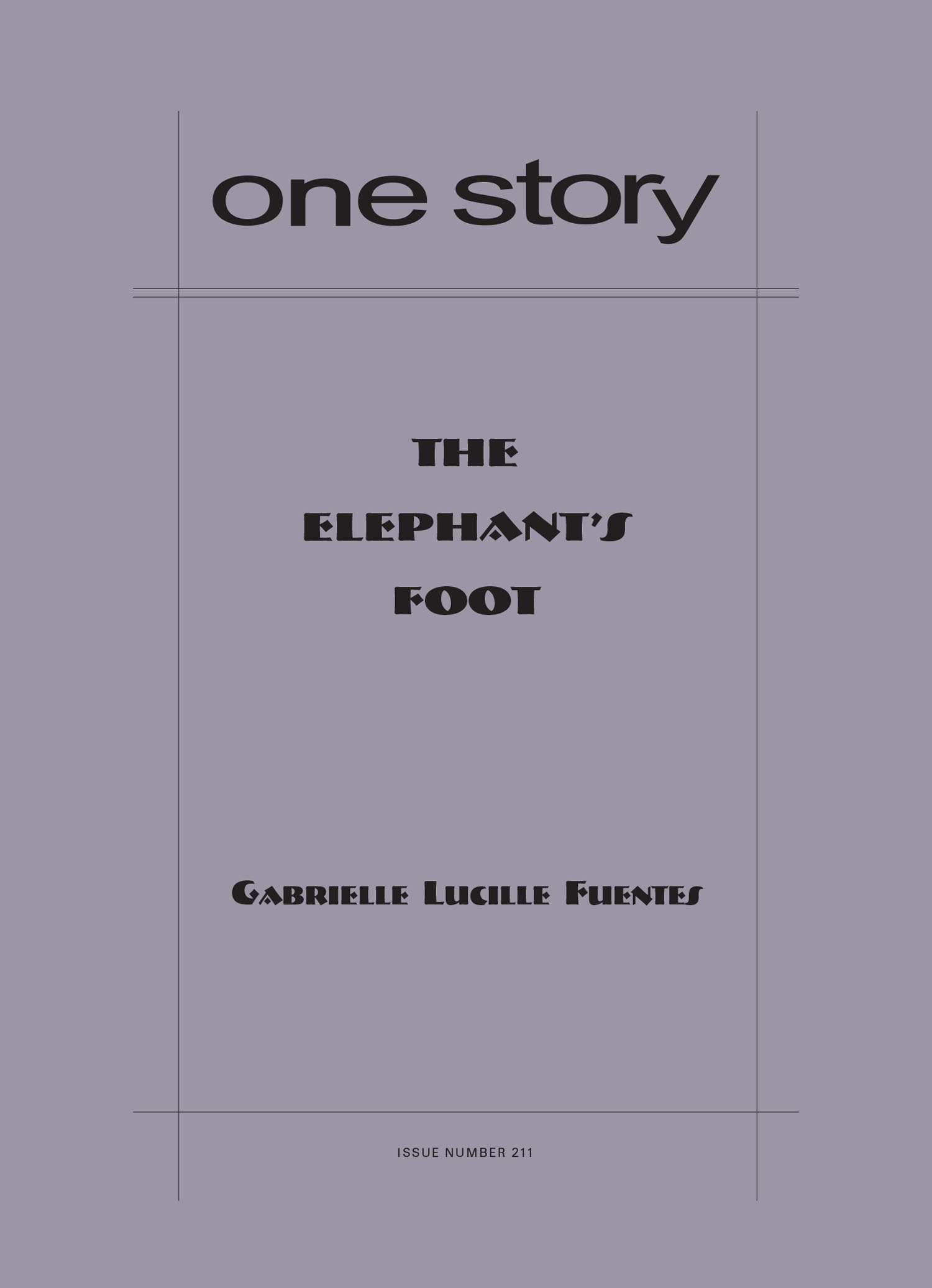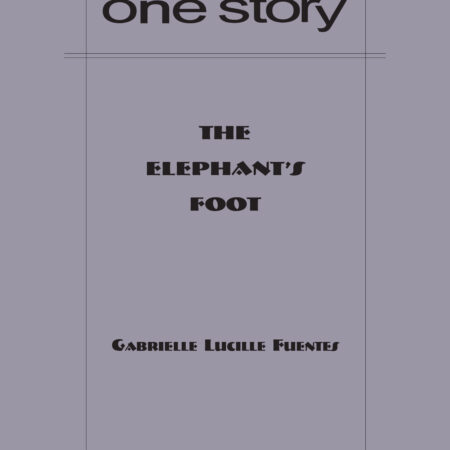
The Elephant’s Foot
$2.50
25 in stock
Excerpt
I first saw the elephant’s foot on the cement run outside of Chapel. Muirenn was jumping rope, her body so steady her wool skirt barely floated above her knees, getting closer to Sandra’s Double Dutch record. I counted under my breath, letting the numbers shape fully in my mind and over my tongue. I didn’t like to say them out loud but pretended instead they were a secret to myself. They were simple numbers but all numbers were simple and they all could be twisted into something strange. In my pocket I ran my fingers over Muirenn’s study cards with the presidents’ names on them, right up to our beloved, newly-elected John Fitzgerald Kennedy, who the nuns had us pray for and who everyone in school claimed to be related to but me. Muirenn had covered his card in red hearts. Whenever she jumped, Muirenn asked me to hold her cards. She said I gave her luck.
Gabrielle Lucille Fuentes
Gabrielle Lucille Fuentes’s first novel will be published by Simon & Schuster (Touchstone) in 2016. Her work has appeared in Pank, The Collagist, Tweed’s, NANO Fiction, Western Humanities Review, The Yoke, SpringGun, and elsewhere. She holds a BA from Brown University, an MFA from the University of Colorado, Boulder and is currently pursuing a PHD at the University of Georgia. She lives in Athens with her husband, the poet Thibault Raoult, and their dog Habana.
Hannah Tinti on “The Elephant’s Foot”
Growing up, I loved to read classic horror tales, like Edgar Allan Poe’s “The Tell-Tale Heart” and “The Monkey’s Paw” by W. W. Jacobs. There was something electric about the writing in those stories that shocked and disturbed, while also revealing dark, mysterious truths about human nature. A similar sense of touching a live wire came through the first time I picked up our new issue, Gabrielle Lucille Fuentes’s “The Elephant’s Foot.” Set in a Catholic School in the 1960s, this captivating story focuses on four young girls pushing the boundaries of their friendship and their imaginations after a mysterious object (an elephant’s foot!) enters their lives. Everything about the foot is extraordinary—from the wild stories about its origins to the way it haunts, then alters, each of the girls. Read Gabrielle’s Q&A with us to find out more about the inspiration behind this chilling tale, which arrives just in time for Halloween.
Q&A by Hannah Tinti
- HT: What was the seed of this story? What was the first thing you wrote?
- GF: I admit I stole the seed. At a party someone was describing their dream—of an elephant’s foot that could tell the future. The dream went on but I don’t remember what else happened. The idea of a fortune telling relic led to the final image of the story, which is usually where I start writing.
- HT: What was the most challenging aspect of writing this story?
- GF: Though the arc of the story came pretty whole cloth, I struggled with some of the details. It was always at a Catholic girls’ school in the 1960s but other aspects of the setting and the characters changed. When I was working on this revision I thought about what drew me personally to this setting and I remembered the stories my father would tell of taking the El to his Catholic school as a kid in Chicago. That really opened up the narrator for me. My father came alone to the U.S. from Cuba and as a young immigrant, he had to learn English and U.S. customs very quickly. My mother too faced a huge cultural and class shift when she left the poor farming community where she’d grown up to attend an elite Catholic women’s college on scholarship. The ability to observe and adapt that my parents both had to develop was also present in the narrator’s character. She was watchful in a way that felt purposeful for me and was not just an issue of a “passive narrator.”
- HT: Why did you decide to set this story in the Where did the idea for this story come fromCan you tell us a little about the titleWhat are you working on now0s? And what drew you to Ceely’s POV?
- GF: The time period wasn’t really a choice—it was part of the story that just arrived. But I think—if I try to unpack and slow down my intuitive process—I wanted a time in which Catholicism was still very strong—though right on the edge of being questioned. A transitional period, still very much stuck in the guilt and shame of the past, but with other possibilities gleaming.
- HT: The relationship of these four girls is very intense, intimate, and competitive. Both friends and enemies. Do you think of this as a story of revenge? Or something else?
- GF: I think in a way it is a tale of revenge but how longing is always the other side of revenge and how the future is the greatest revenge of all. I like the story arc of Let the right one in: after the revenge occurs, the story continues to an ending that only broadens the narrative and the characters. I’m interested in stories in which all of the characters are culpable of the things they do to each other or when there is a certain glitch in their moral fiber—I’m thinking of Sula in particular. But I don’t really think about these aspects until several drafts in or when I’m asked questions like this!
- HT: The Elephant’s Foot is wrapped in mystery. But the most intriguing aspect is its ability to tell the future. Why do you think that becomes so important for these four girls?
- GF: It’s a play on those games like MASH or Cootie Catchers where you asked questions about your future. You have so little control over your life as a child, it’s exciting to dream of a time when you are more your own person—even if that may not actually be the case with adulthood. The characters in this story are right on the cusp of becoming teens and right on the cusp of a huge change in how women and sexuality are viewed. I don’t think they’re looking for stability in seeking knowledge of the future—they’re looking for danger. They want to encounter the unknown because they feel it all around and inside them.
- HT: Much of this story brings to mind the creepiness of “The Monkey’s Paw” by W.W. Jacobs, or “The Black Cat” by Edgar Allan Poe. Was “The Elephant’s Foot” at all inspired by classic tales of horror?
- GF: Absolutely. I read a lot of Poe when I was a kid and I definitely read the “The Monkey’s Paw.” Though I have little interest in horror films, these stories really shaped my aesthetics. I like horror that walks the line between kitsch and a mystery that is never totally explained. In Cuban culture, speaking to spirits is very real and can be very dangerous, so between that and a reading diet of Brian Evenson and Shirley Jackson, I take these matters seriously.
- HT: How long did it take you to complete this story?
- GF: I worked on it off and on for several years.
- HT: What are you working on now?
- GF: I’m writing a novel set on a religious commune in Wisconsin in the 1930s. It began as an American retelling of Wuthering Heights and has since morphed and stretched. There’s an atlas that contains all the world’s origin and apocalypse myths. There’s bootlegging and revivals. I’m still very much in the muck but will hopefully have a draft soon.
- HT: What can you tell us about your forthcoming novel?
- GF: The Sleeping World is set in Spain, 1977. The dictator of over forty years has died and there’s a vacuum of power. Punk music oozes out of illegal basement bars. Fascists fight anarchists for the future of the country and the definition of its culture. The novel is about a group of students who are caught up in the turmoil and loss of this period, who want something different but have no idea how to build it.
- HT: What is the best bit of advice about writing you have ever received?
- GF: Reginald McKnight told me that the first person perspective can be as big as I can imagine, as expansive as I am.
